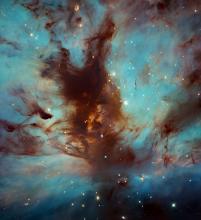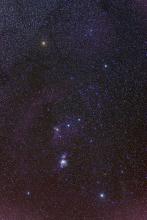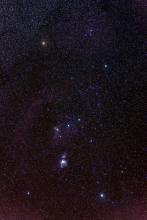Listen to today's episode of StarDate on the web the same day it airs in high-quality streaming audio without any extra ads or announcements. Choose a $8 one-month pass, or listen every day for a year for just $30.
You are here
Last Glance
This time of year is pretty inviting for a little evening skywatching. The evening hours are warm but not usually too hot, and thunderstorm activity generally hasn’t reached its peak — perfect conditions for watching the stars.
Unfortunately, though, one of the most beautiful star patterns is dropping from view about now, so there aren’t many more days to enjoy it.
Orion, the hunter, is low in the west as night falls. Its three-star belt stands almost parallel to the horizon. And its two brightest stars bracket the belt: orange Betelgeuse above, and blue-white Rigel below.
Orion always climbs into prominence in the evening sky around Thanksgiving and Christmas. At that time of year, in fact, it’s in view for most of the night.
As the months roll by, though, so does Orion. The constellation rises earlier each night, so by late February, it’s already halfway across the southern sky at nightfall.
And now, it’s about to disappear from view. There’s only about an hour of really good viewing time — between the end of twilight and the time Orion’s stars begin to set. And that viewing window gets shorter by the night. In a couple of weeks, it’ll be hard to see the constellation at all.
Fortunately, though, there’s still a lot to look at after Orion passes from view. And the hunter won’t stay gone forever. He’ll begin to climb into the morning sky in August — and will return to the evening sky during the long, chilly nights at year’s end.
Script by Damond Benningfield






